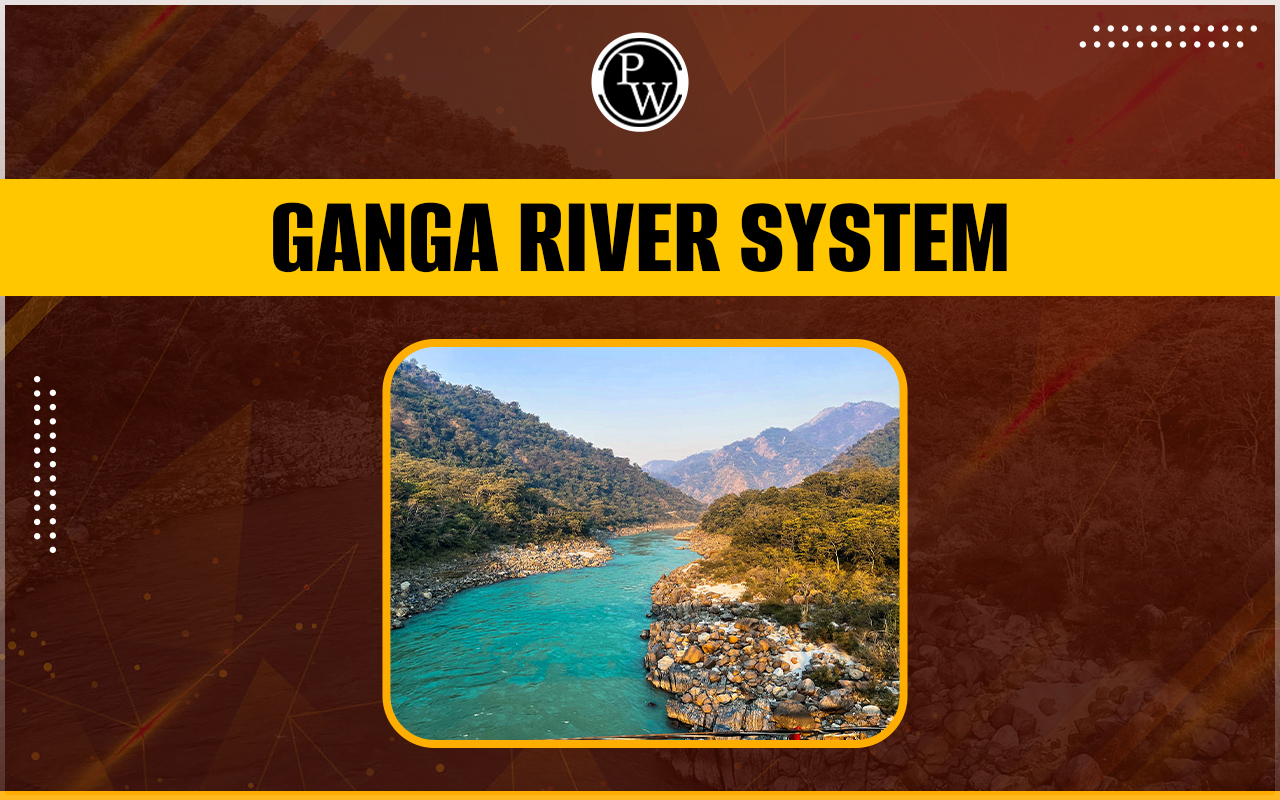

Ganga River System
The Ganga River, also known as the Ganges, holds immense cultural, religious, and ecological significance in India. Originating from the Gangotri Glacier in the Himalayas, it flows through several states in northern India before merging with the Bay of Bengal. The Ganga River system comprises not only the main stem but also its tributaries, distributaries, and associated ecosystems. This article looks into the various aspects of the Ganga River system, exploring its geography, importance, challenges, and conservation efforts.Geography of Ganga River System
The Ganga River system is one of the largest river basins in the world, covering a vast expanse of northern India. It can be divided into three main sections:- Upper Ganga : The upper reaches of the Ganga originate from the Gangotri Glacier in the Himalayas, near the Indo-Tibetan border. From its source, it flows through the states of Uttarakhand and Uttar Pradesh, passing through cities like Rishikesh, Haridwar, and Kanpur.
- Middle Ganga : The middle section of the Ganga includes its course through Uttar Pradesh and Bihar. This stretch is characterized by fertile plains and densely populated regions. Major cities along the middle Ganga include Allahabad, Varanasi, and Patna.
- Lower Ganga : The lower Ganga refers to the deltaic region where the river empties into the Bay of Bengal. This delta, known as the Sundarbans, is shared between India and Bangladesh and is one of the largest mangrove forests in the world.
Importance of the Ganga River
The Ganga River holds great importance for India, comprising religious, cultural, economic, and ecological aspects:- Religious and Cultural Significance : The Ganga is considered sacred in Hinduism, and millions of people participate in rituals and ceremonies along its banks. It is believed to purify the soul and grant salvation to those who bathe in its waters. Numerous ghats, temples, and pilgrimage sites line the river, attracting devotees from across the country and beyond.
- Economic Importance : The Ganga River basin supports a significant portion of India's population and economy. It provides water for irrigation, drinking, and industrial purposes, supporting agriculture, fisheries, and other livelihoods. The river also serves as a major transportation route, facilitating trade and commerce in the region.
- Ecological Value : The Ganga River system sustains diverse ecosystems, including wetlands, floodplains, and mangrove forests. These habitats support a rich biodiversity of plant and animal species, many of which are endemic or endangered. The river also plays a crucial role in regulating the local climate and hydrological cycle.
- Historical Legacy : The Ganga has been a cradle of civilization for millennia, with ancient cities and kingdoms flourishing along its banks. It has witnessed the rise and fall of empires, the spread of culture and ideas, and the confluence of diverse peoples and traditions.
Challenges Facing the Ganga River System
Despite its significance, the Ganga River faces numerous challenges that threaten its health and sustainability:- Pollution : The Ganga is one of the most polluted rivers in the world, primarily due to untreated sewage, industrial effluents, agricultural runoff, and solid waste. Pollution levels are especially high in urban areas, where rapid urbanization and inadequate waste management exacerbate the problem.
- Sedimentation and Erosion : Deforestation, soil erosion, and unsustainable land use practices in the Himalayan region contribute to sedimentation and siltation in the Ganga River. This reduces water quality, disrupts aquatic ecosystems, and increases the risk of floods and landslides.
- Dams and Water Diversion : The construction of dams, barrages, and irrigation canals along the Ganga and its tributaries has altered natural flow regimes and fragmented habitats. Water diversion for agriculture, hydropower generation, and urban consumption has reduced downstream flow, affecting ecosystems and livelihoods.
- Loss of Biodiversity : Habitat destruction, pollution, overfishing, and invasive species have led to a decline in the biodiversity of the Ganga River. Many native species of fish, turtles, dolphins, and other aquatic organisms are threatened or endangered due to habitat loss and degradation.
- Climate Change : The impacts of climate change, including rising temperatures, altered precipitation patterns, and extreme weather events, have additional challenges to the Ganga River system. Glacial melt in the Himalayas, for example, affects the river's flow and water availability, while sea-level rise threatens coastal areas in the deltaic region.
Conservation Efforts and Initiatives
To address the challenges facing the Ganga River, various conservation efforts and initiatives have been undertaken by the government, non-governmental organizations, and local communities:- Namami Gange Programme : Launched by the Government of India in 2014, the Namami Gange Programme aims to rejuvenate and clean the Ganga River. It includes measures such as sewage treatment plants, riverfront development, afforestation, and public awareness campaigns.
- Pollution Control Measures : Efforts are underway to reduce pollution in the Ganga River through improved sewage treatment, industrial effluent regulation, solid waste management, and enforcement of environmental laws. The installation of sewage treatment plants and the promotion of eco-friendly practices are priorities.
- River Rejuvenation Projects : Various projects are focused on restoring the ecological health of the Ganga River, including riverfront restoration, wetland conservation, and biodiversity conservation. These projects aim to revive degraded habitats, enhance water quality, and promote sustainable river management practices.
- Community Participation : Engaging local communities in conservation and management efforts is essential for the long-term sustainability of the Ganga River. Community-based initiatives such as river clean-up drives, tree planting campaigns, and sustainable livelihood programs empower stakeholders to take ownership of their natural resources.
- International Collaboration : Given the transboundary nature of the Ganga River, cooperation with neighboring countries like Bangladesh is crucial for effective river basin management. Bilateral and multilateral agreements, joint monitoring mechanisms, and shared best practices facilitate collaboration on issues such as water quality, flood management, and biodiversity conservation.
Ganga River System FAQs
What is the Ganga River System?
It's a network of rivers originating in the Himalayas, including the Ganga, Yamuna, and tributaries.
Why is the Ganga River important?
It's culturally significant, providing water for irrigation, drinking, and supporting diverse ecosystems.
Which states does the Ganga River flow through?
It traverses Uttarakhand, Uttar Pradesh, Bihar, and West Bengal before entering the Bay of Bengal.
What challenges does the Ganga River face?
Pollution, over-extraction, and erosion threaten its health, impacting communities and biodiversity.
🔥 Trending Blogs
Talk to a counsellorHave doubts? Our support team will be happy to assist you!

Check out these Related Articles
Free Learning Resources
PW Books
Notes (Class 10-12)
PW Study Materials
Notes (Class 6-9)
Ncert Solutions
Govt Exams
Class 6th to 12th Online Courses
Govt Job Exams Courses
UPSC Coaching
Defence Exam Coaching
Gate Exam Coaching
Other Exams
Know about Physics Wallah
Physics Wallah is an Indian edtech platform that provides accessible & comprehensive learning experiences to students from Class 6th to postgraduate level. We also provide extensive NCERT solutions, sample paper, NEET, JEE Mains, BITSAT previous year papers & more such resources to students. Physics Wallah also caters to over 3.5 million registered students and over 78 lakh+ Youtube subscribers with 4.8 rating on its app.
We Stand Out because
We provide students with intensive courses with India’s qualified & experienced faculties & mentors. PW strives to make the learning experience comprehensive and accessible for students of all sections of society. We believe in empowering every single student who couldn't dream of a good career in engineering and medical field earlier.
Our Key Focus Areas
Physics Wallah's main focus is to make the learning experience as economical as possible for all students. With our affordable courses like Lakshya, Udaan and Arjuna and many others, we have been able to provide a platform for lakhs of aspirants. From providing Chemistry, Maths, Physics formula to giving e-books of eminent authors like RD Sharma, RS Aggarwal and Lakhmir Singh, PW focuses on every single student's need for preparation.
What Makes Us Different
Physics Wallah strives to develop a comprehensive pedagogical structure for students, where they get a state-of-the-art learning experience with study material and resources. Apart from catering students preparing for JEE Mains and NEET, PW also provides study material for each state board like Uttar Pradesh, Bihar, and others
Copyright © 2025 Physicswallah Limited All rights reserved.
Get App











